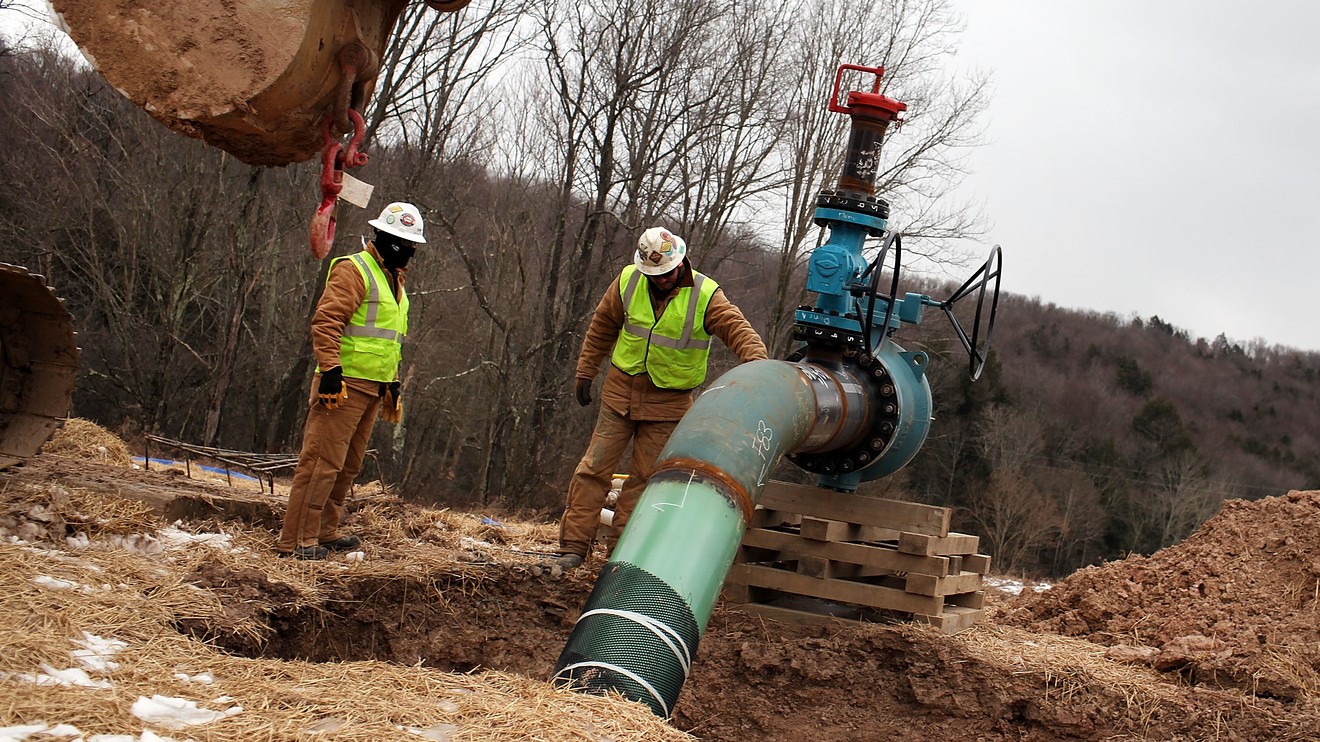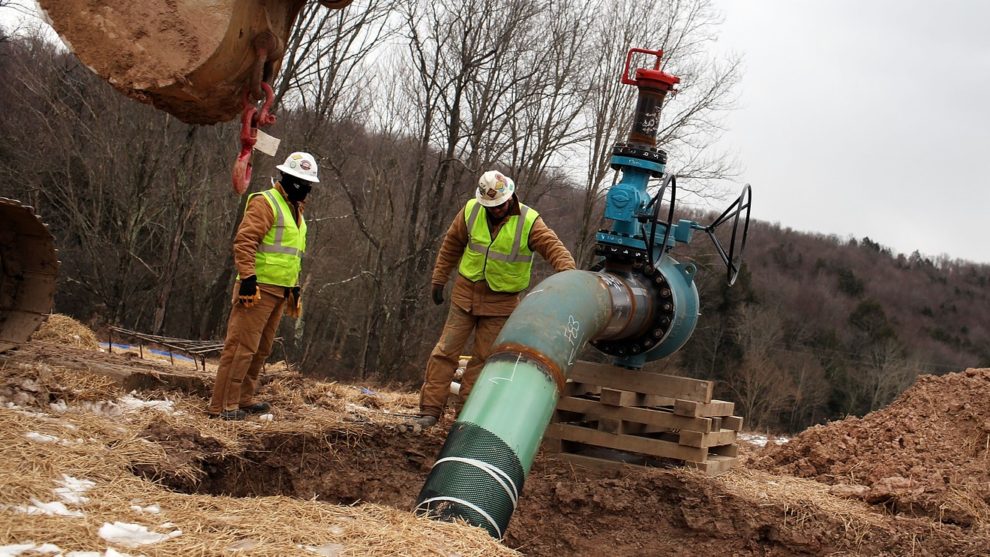
The debate over fracking in 2020 battleground state Pennsylvania divides the last major Democrats vying for the party’s backing for president — a policy distinction that has wider implications as the U.S. tightens its clasp on energy independence against heavyweights Saudi Arabia and Russia.
Former Vice President Joe Biden and Sen. Bernie Sanders of Vermont will emphasize their narrowing energy-policy differences in coming weeks; Pennsylvania’s Democratic primary is set for April 28. Their pro-fracking rival on the Republican side, President Donald Trump, has been clear in his push to keep fossil fuels, especially domestic production, in the energy mix. Trump won Pennsylvania during his unexpected march to the White House four years ago, which made him the first Republican presidential candidate to carry the commonwealth since 1988.
Pennsylvania’s election role is significant for the vote tally alone. But its energy-pegged economy and mix of rural and urban demographics positions the commonwealth as a test for nationwide sentiment on traditional fossil fuels. That includes relatively cleaner and cheaper natural gas, which increasingly powers electric utilities. Fracking has, in a few short years, lifted Pennsylvania to the No. 2 ranking among U.S. natural-gas producers, behind only Texas.
Biden’s energy and climate-change plan includes a ban on Arctic oil drilling, and for the first time, during the March 15 debate, he implied a shift from wanting tighter regulations on fracking to now supporting the banning of new fracking. Or did he?
Sanders said Sunday he wanted to stop “fracking as soon as we possibly can,” adding he was “talking about telling the fossil fuel industry that they are going to stop destroying this planet — no ifs, buts and maybes about it.”
Biden responded: “So am I,” seemingly agreeing with a ban before saying, ”No more — no new fracking … no more drilling on federal lands.”
“Biden’s proposal to ban only ‘new’ manufacturing is too cute by half,” said Mark Mills, Manhattan Institute senior fellow. “Just as with manufacturing or farming, fracking is a continual process. So banning ‘new’ output quickly becomes an overall ban.”
Sanders has long called for a national fracking moratorium and made a plug for the aggressive and comprehensive Green New Deal framework. It’s that plan, or a variation thereon, that Sanders believes can help move oil- and coal-industry workers into higher-paying green infrastructure jobs. For sure, calls for banning fracking are widening the fault lines between Pennsylvania’s Democrats and their traditional allies in organized labor, many of whose members work in the energy industries.
“I’m not sure how anybody in their right mind thinks they might win Pennsylvania on a fracking ban,” said Frank Maisano, senior principal at Policy Resolution Group, who has a focus on energy issues. “There is a small, but vocal, group of activists [against the practice], but then there are unions, small business and just about everybody else that benefits from a shale-drilling economy.”
Maisano said, for instance, that endangered rural hospitals in some parts of the state are beneficiaries of natural-gas-linked funding. The energy sector in Pennsylvania adds $45 billion to the commonwealth’s economy and has contributed more than 300,000 jobs, according to the U.S. Chamber of Commerce.
Both Biden and Sanders would promptly rejoin the climate change-focused Paris Agreement that Trump has quit. Both would invest heavily in clean energy research. Both want to reach net-zero carbon emissions before mid-century, although Sanders’s plan proposes a substantially faster and more absolute elimination of fossil fuels.
For now, the rise of natural gas also gives new life to the accompanying debate on methane leaks during natural-gas extraction, especially their contribution to raising average global temperatures. Hydraulic fracturing uses high-pressure, chemical-laced liquid to extract oil, and secondarily, gas, at shale sites. The process increases seismic-activity risk, water contamination and other factors, say fracking’s critics.
The fracking issue currently plays out against extreme energy-market volatility. Saudi Arabia and Russia — two of the biggest U.S. energy rivals, with geopolitical strings attached — are dancing around a global price war. This uncertainty dealt the oil market its biggest one-day price drop since 1991. The tension is fueled by the U.S.’s rise to energy independence, in part because of its shale bounty. The Trump administration on Tuesday was seen as likely to push federal aid for shale companies hit by the international energy shock and the coronavirus outbreak, the Washington Post reported.
Along with new horizontal drilling techniques, fracking has unlocked new volumes of natural gas and oil from shale deposits in the U.S. over just the past decade-plus. That helped turn the U.S. from the world’s biggest oil importer into the world’s biggest oil and gas producer, which some energy analysts stress gives the U.S. an edge in curbing greenhouse-gas emissions by earning a bigger say on the international energy-policy stage.
“Up to recently, before the U.S. shale-gas revolution, Russia was the country which was dominating, alone, the gas markets,” Fatih Birol, executive director of the International Energy Agency, said in a CNBC interview last year. “With the U.S. coming into the picture, there is a choice, there are options for the consumers, better for energy security, for diversification.”
At what cost
The methane that is emitted from the process has 86 times the global-warming potential of carbon dioxide over a 20-year period, according to the Union of Concerned Scientists. It is the main component of natural gas, and, when companies drill for oil, they generally also get natural gas. Methane is released in the atmosphere during the extraction and distribution of natural gas, and, while many scientists agree this is a major problem, there is little data to show exactly how much is leaking into the atmosphere.
With shale in their back yards, Pennsylvania voters remain divided, according to a statewide Morning Call/Muhlenberg College poll. It found 42% of Pennsylvanians oppose a ban on fracking and 38% support a moratorium, with 20% undecided.
A poll from the same source taken in late February, before Sen. Elizabeth Warren of Massachusetts had withdrawn from the presidential race, showed Trump doing better against potential Democratic rivals than he did in a similar poll three months earlier, especially in potential matchups with Biden and Warren. Sanders maintained a slight lead over the president in hypothetical matchups at that time.
In the Philadelphia suburbs that have been trending Democratic, some voters have shown a growing opposition to the drilling and massive pipelines (sometimes right through their neighborhoods) required to move fracked material to refineries, the Associated Press has reported.
Chester and Delaware counties in the Philadelphia suburbs, for example, have more than 750,000 voters, which is roughly 9% of the voters in Pennsylvania. The two counties sit between the shale-gas fields on the western side of the state and the industrial hub of Philadelphia. To connect the two, companies are cutting through lawns and near schools to lay pipelines, E&E EnergyWire has reported. Trump won the state by fewer than 45,000 votes in 2016.
Republican U.S. Sen. Pat Toomey of Pennsylvania has framed a fracking ban as a tough choice for Americans between affordable energy and unaffordable energy. Pennsylvania’s top Democrats, including Gov. Tom Wolf and U.S. Sen. Bob Casey, have tried to discourage talk of a fracking ban, while labor leaders point to thousands of building-trades members working on gas drilling sites, laying billions of dollars in pipelines and building massive refineries, the Associated Press has reported.
”The shale revolution started in Texas, but the oil patch is no longer just Texas and Oklahoma. The Mid-Atlantic [region] and the upper Plains are producers, too, and the entire country is benefiting,” said Martin Durbin, president of the Chamber of Commerce’s Global Energy Institute.
“Now that natural gas is the largest source of electricity … and fracking has lowered its cost, that’s what has given us the ability to lower carbon emissions [over coal use and other traditional fossil fuels],” Durbin said.
Age and other demographics, more so than party, may sway the energy vote. In November, the Pew Research Center released a national poll showing that rising percentages of millennial Republicans believe the federal government is not doing enough on climate. Other surveys have found similar trends.
Many politicians consider natural gas, even with the methane problem, a transitional fuel that helps the U.S. move away from heavier fossil fuels. But the natural-gas bridge to a carbon-free future must have a clear end date, say environmental advocates.
Read: Why climate change is also a health care story — it’s the biggest health threat this century
Never a sure thing
Energy companies themselves seem well aware of the political (and geopolitical) uncertainty. Williams Cos. WMB, -14.67% and partners Duke Energy Corp. DUK, -10.71% , Cabot Oil & Gas Corp. COG, -6.86% and AltaGas Ltd. ALA, -13.18% this year canceled plans for the 125-mile Constitution pipeline, an interstate natural-gas pipeline that would have crossed through New York’s Catskill Mountains.
“While Constitution did receive positive outcomes in recent court proceedings and permit applications, the underlying risk-adjusted return for this greenfield pipeline project has diminished in such a way that further development is no longer supported,” Williams representatives reportedly told E&E EnergyWire.
Opponents of the project — who had fought Constitution for roughly eight years — said the project’s interruption showed how persistence against fossil fuels can pay off.
Don’t miss: J.P. Morgan Chase — the oil industry’s bank of choice — will withdraw support for some fossil fuels
“As climate change increases risk to investor portfolios, shareholders must scrutinize what role fossil gas can play in the inevitable transition to a clean-energy economy,” said Lila Holzman, the energy-program manager at the sustainable-investing advocate As You Sow. “Utilities clinging to business models that rely on fossil fuels are jeopardizing their ability to meet critical climate goals (including their own) and will miss out on opportunities to benefit from new technology advances.”
The question remains whether key Pennsylvania voters — whose paychecks and less-volatile electricity costs right now might supersede their 401(k) balances later on — share the longer-term vision of environmentalists, their local leadership and a Trump administration push to secure energy independence.
More importantly to the November outcome, does the broader U.S. mirror a diverse Pennsylvania on energy?
Don’t miss: Republican ‘tree huggers’ face off against emission-slashing Democrats with congressional legislation
div > iframe { width: 100% !important; min-width: 300px; max-width: 800px; } ]]>











Add Comment